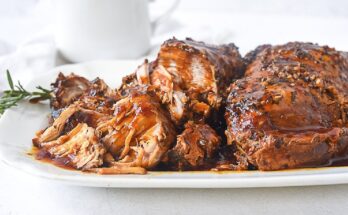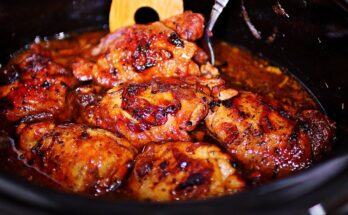Baked Fish Recipe: Fish has always held a special place on the dining table, whether you’re enjoying a light weekday meal or preparing a feast for guests. Among the many ways to prepare fish, baking is often seen as one of the easiest, healthiest, and most flavorful methods. Unlike frying, which can be greasy, or grilling, which isn’t always convenient, baked fish offers a perfect balance of tenderness, nutrition, and simplicity.
Why Baked Fish is a Healthy Choice
One of the top reasons people love baked fish is its nutritional value. Fish is naturally rich in protein and omega-3 fatty acids, both of which play a huge role in keeping your body strong and healthy. Baking allows the fish to retain most of its nutrients without drowning it in oil. Unlike deep-fried options, baked fish has fewer calories and is much lighter on the stomach. Plus, the cooking method doesn’t require fancy techniques—just a simple oven setup.
The Simplicity of Home-Cooked Seafood
You don’t need to be a professional chef to make a delicious baked fish dish. With just a handful of ingredients and a step-by-step approach, you can create a meal that’s restaurant-worthy yet simple enough for beginners. The beauty of baked fish lies in its versatility: you can keep it plain with lemon and salt, or dress it up with herbs, spices, and marinades. This flexibility makes it a go-to recipe for both quick dinners and special occasions.
Ingredients You’ll Need
Before you begin, having the right ingredients on hand will make your cooking process smooth and stress-free. The best part about baked fish is that you don’t need a long shopping list—just a few quality items that bring out the natural flavors of the fish.
Choosing the Right Type of Fish
When it comes to baked fish, choosing the right kind is key. Some of the most popular options include salmon, cod, tilapia, trout, and snapper. Each variety brings its own flavor and texture:
- Salmon – rich and flavorful, perfect for those who like a meaty texture.
- Cod – mild and flaky, making it ideal for beginners.
- Tilapia – light and versatile, absorbs flavors easily.
- Trout – delicate with a slightly nutty taste.
- Snapper – firm and lean, great for citrus-based marinades.
Essential Herbs and Spices
Seasoning is what takes baked fish from good to amazing. At minimum, you’ll need:
- Salt and black pepper
- Garlic (fresh or powdered)
- Paprika or chili flakes (for a kick)
- Lemon or lime (for brightness)
- Fresh herbs like parsley, dill, or thyme
These spices don’t just enhance flavor—they balance the natural taste of fish without overpowering it.
Additional Ingredients for Flavor
Depending on your taste, you can add a few extras:
- Olive oil or melted butter for richness
- Sliced onions or bell peppers for sweetness
- Cherry tomatoes for a burst of freshness
- White wine for a gourmet touch
By mixing and matching these ingredients, you can customize your baked fish recipe to suit any occasion.
Tools and Equipment Required
Cooking baked fish doesn’t demand a fancy kitchen. With just a few basic tools, you’ll be ready to prepare a dish that looks and tastes professional.
Baking Dish and Foil Options
A simple baking dish or tray is essential. Glass, ceramic, or non-stick metal pans all work well. Lining the dish with foil or parchment paper not only prevents sticking but also makes cleanup a breeze. For added moisture, you can cover the fish loosely with foil while baking, which traps steam and keeps the fish tender.
Kitchen Essentials for Preparation
Here are the must-haves:
- A sharp knife for slicing and trimming fish
- A cutting board
- Mixing bowls for marinades
- Measuring spoons for spices
- A brush or spoon for spreading oil or butter
Having everything prepared in advance saves you from last-minute stress and ensures your fish cooks evenly.
Preparing the Fish
Proper preparation makes all the difference between an average dish and a standout baked fish recipe. From cleaning to seasoning, these steps set the foundation for the final flavor.
How to Clean and Prep Fish Properly
If you’re working with whole fish, start by scaling and gutting it—or ask your fishmonger to do it for you. For fillets, all you’ll need to do is rinse them under cold water and pat them dry with paper towels. Moisture is the enemy of crispy, flavorful skin, so drying is key. Once prepped, check for any small bones and remove them with tweezers.
Marinating for Maximum Flavor
Marinating is optional but highly recommended. Even a quick 15–20 minute marinade can elevate your fish to the next level. A simple mix of olive oil, lemon juice, garlic, and herbs works wonders. For stronger flavors, you can add soy sauce, ginger, or mustard. Marinating doesn’t just infuse flavor—it also tenderizes the fish, making it moist and delicious after baking.
Step-by-Step Guide to Baking Fish
Now that your fish is prepped and your oven is ready, it’s time for the main event. Baking fish is simple, but timing and seasoning make all the difference.
Step 1: Preheat the Oven
Always start with a hot oven. Preheating to around 375°F (190°C) ensures the fish cooks evenly from the start. A properly preheated oven helps lock in moisture and flavor, preventing the fish from drying out.
Step 2: Seasoning the Fish
Place the fish in your baking dish and season generously. A drizzle of olive oil, a sprinkle of salt and pepper, and a few lemon slices are often all you need. If you prefer bold flavors, layer on paprika, garlic, or chili flakes. Make sure to season both sides for even taste.
Step 3: Baking the Fish to Perfection
Cooking time depends on the thickness of your fish. As a general rule, bake for 10 minutes per inch of thickness. For example, a 1-inch salmon fillet needs around 12 minutes, while a thicker cod fillet may take up to 18 minutes. Covering with foil at the start can keep moisture in, but uncovering in the final minutes adds a light crispness to the top.
Step 4: Checking for Doneness
The easiest way to check if fish is done is to use a fork. The flesh should flake easily and turn opaque. If it still looks translucent in the center, give it a couple more minutes. A food thermometer is also handy—fish is safe to eat at 145°F (63°C).
Step 5: Resting and Serving
Just like meat, fish benefits from a short resting period. Let it sit for 3–5 minutes before serving. This allows the juices to redistribute, keeping every bite moist and flavorful. Serve immediately with your choice of sides and garnish with fresh herbs or lemon wedges for a finishing touch.
Tips for Perfectly Baked Fish
Cooking fish can feel intimidating at first, but once you understand the basics, it’s one of the easiest proteins to prepare. To make sure your baked fish always turns out moist, flaky, and full of flavor, a few simple tips can go a long way.
Avoiding Overcooking
One of the most common mistakes is leaving fish in the oven too long. Because fish is leaner than meat, it cooks much faster. A good rule of thumb is the “10-minute rule”—bake for 10 minutes per inch of thickness. For delicate varieties like tilapia or trout, even 8 minutes may be enough. Overcooking can cause the fish to dry out and lose its natural flavor. If you’re unsure, check the fish early rather than late. Remember, you can always bake it a little longer, but you can’t fix an overcooked piece.
Enhancing Flavor with Citrus and Herbs
Fish naturally pairs well with citrus fruits like lemon, lime, or orange. A squeeze of fresh juice before serving can brighten the dish instantly. Herbs like dill, parsley, rosemary, and thyme add fragrance and depth without overpowering the fish. A trick many chefs use is layering lemon slices directly on the fish while baking. This not only adds flavor but also keeps the fish moist. If you enjoy bolder flavors, try adding a touch of chili flakes or smoked paprika.
Popular Variations of Baked Fish Recipes
The beauty of baked fish lies in its versatility. You can keep it classic with just salt and lemon, or you can explore different cultural flavors by switching up the herbs, spices, and marinades. Here are some delicious variations you can try at home.
Mediterranean Style Baked Fish
Mediterranean cuisine is known for its light, fresh flavors. To make this version, season your fish with olive oil, garlic, lemon, and oregano. Add cherry tomatoes, olives, and red onions to the baking dish for a colorful, flavorful twist. The result is a bright and tangy dish that feels both healthy and satisfying.
Asian Inspired Baked Fish
For an Asian-style baked fish, create a marinade with soy sauce, ginger, garlic, sesame oil, and a dash of honey. Let the fish soak for 20–30 minutes before baking. Garnish with fresh cilantro and a sprinkle of sesame seeds before serving. This variation gives your fish a sweet-salty flavor profile with a hint of spice.
Spicy Garlic Baked Fish
If you love bold flavors, this one’s for you. Coat your fish with olive oil, minced garlic, paprika, chili flakes, and a touch of cayenne pepper. Bake until golden and fragrant. This version is perfect for spice lovers who want a kick of heat balanced with the natural sweetness of fish.
Side Dishes to Serve with Baked Fish
A well-baked fish deserves equally delicious sides. Choosing the right accompaniment enhances the meal and makes it feel complete. Luckily, baked fish pairs well with both light and hearty dishes.
Light Salads and Vegetables
Freshness always complements fish. A crisp garden salad with cucumbers, tomatoes, and lettuce works beautifully. You can also roast vegetables like asparagus, zucchini, and bell peppers alongside the fish for an easy one-pan meal. Steamed broccoli or sautéed green beans are also excellent choices.
Rice, Potatoes, and Grains
If you prefer something more filling, go with classic starches. Fluffy white rice or brown rice makes a great base. Roasted potatoes seasoned with garlic and rosemary pair wonderfully with baked fish. For a healthier twist, try quinoa, couscous, or wild rice—they add texture and nutrition without being too heavy.
Nutritional Benefits of Baked Fish
Beyond its taste, baked fish is one of the healthiest meals you can prepare. It’s light, nourishing, and packed with essential nutrients your body needs.
Protein and Omega-3 Richness
Fish is one of the best natural sources of lean protein, making it a great option for muscle growth and repair. It’s also rich in omega-3 fatty acids, which are known to improve heart health, reduce inflammation, and boost brain function. Regularly including fish in your diet can contribute to better overall health.
Low-Calorie, Heart-Healthy Option
Compared to fried or heavily sauced meals, baked fish is naturally low in calories and fat. This makes it ideal for people watching their weight or following a clean-eating lifestyle. Combined with vegetables or whole grains, it forms a balanced, nutrient-dense meal that supports heart health and overall wellness.
Common Mistakes to Avoid
Even though baked fish is simple, a few mistakes can make it less enjoyable. Knowing what to avoid will help you get it right every time.
Over-Seasoning or Under-Seasoning
Fish has a delicate flavor, so balance is key. Too much salt or spice can overpower the natural taste, while too little seasoning can make it bland. Aim for a simple seasoning base—salt, pepper, lemon, and olive oil—and then add extra herbs or spices according to your taste.
Not Monitoring Cooking Time
Unlike meat, fish doesn’t benefit from extra time in the oven. Overbaking can make it tough and dry. Always set a timer and check for doneness a few minutes early. Remember, fish continues to cook slightly even after being removed from the oven.
Storing and Reheating Leftover Baked Fish
If you’ve made more than you can finish, don’t worry—baked fish stores and reheats well with the right approach.
Best Storage Practices
Cool the fish completely before storing it. Place it in an airtight container and refrigerate for up to 3 days. For longer storage, you can freeze baked fish for up to 2 months. Just make sure to wrap it tightly in foil or freezer-safe bags to prevent freezer burn.
How to Reheat Without Drying Out
Reheating fish can be tricky since it tends to dry out quickly. The best way is to use a low-temperature oven—around 275°F (135°C)—and warm it for 10–15 minutes. You can also add a splash of water or cover the dish with foil to retain moisture. Avoid microwaving if possible, as it can make the fish rubbery.
FAQs about Baked Fish Recipe
What’s the best fish to bake for beginners?
Cod and tilapia are great choices—they’re mild, flaky, and cook quickly.
Do I need to marinate fish before baking?
Not always, but marinating enhances flavor and helps keep the fish tender.
Can I bake frozen fish directly?
Yes, but it’s best to thaw it first for even cooking and better texture.
How do I keep baked fish from sticking to the pan?
Line your baking dish with foil or parchment paper and drizzle with oil.
What temperature should fish be baked at?
375°F (190°C) is ideal for most fish—it keeps them moist while cooking evenly.
Conclusion
Baked fish is one of the easiest and healthiest meals you can make at home. With just a few simple ingredients, the right preparation, and a bit of attention to cooking time, you can serve up a dish that’s both delicious and nourishing. Whether you stick to a classic lemon-and-herb recipe or try a bold variation, baked fish is versatile enough to suit any taste. Pair it with fresh vegetables, grains, or salads, and you’ll have a meal that feels light yet satisfying. Next time you’re craving seafood, skip the frying pan and let your oven work its magic—you won’t be disappointed.



